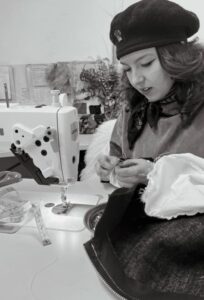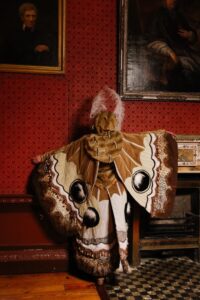
Amie Egan, Irish fashion and costume designer, has left her mark in the creative hubs of Dublin, London, and New York after recently partnering with creatives such as Isadora Epstein, Frank Sweeney, Eimear Walshe, and Sonia Shiel.
Her signature? A fusion of visual art and fashion. Renowned for her handcrafted outerwear that captures the shifting rhythms of Irish nature and weather, Egan’s pieces have recently graced the shelves of prestigious stores such as Brown Thomas and Fabiani Boutique, establishing their place in a new home that allows them to captivate and inspire.
1. Having recently designed costumes for Eimear Walshe and Sarag Greavu’s Installation, ‘Romantic Ireland’ at Venice Biennale this summer, how do you view the relationship between costume design and fashion design? Are there specific elements from costume design that influence your pieces?
 In my work I pursue two distinct avenues – my fashion brand, AMIE EGAN, and my costume design practice, where I create costumes for visual art performances. Fashion design and costume design serve different purposes, they exist in different contexts and hold different values. The intentions and expectations of a customer buying a fashion garment are not the same as those of a client commissioning a bespoke costume for an art performance. It is important to me to maintain boundaries between the two disciplines in order to preserve the integrity of each.
In my work I pursue two distinct avenues – my fashion brand, AMIE EGAN, and my costume design practice, where I create costumes for visual art performances. Fashion design and costume design serve different purposes, they exist in different contexts and hold different values. The intentions and expectations of a customer buying a fashion garment are not the same as those of a client commissioning a bespoke costume for an art performance. It is important to me to maintain boundaries between the two disciplines in order to preserve the integrity of each.
Though I approach the two disciplines separately, they naturally inform one another. My background in design and my interest in contemporary fashion continue to influence my taste and concept development. When working on a costume brief, I may unconsciously approach the development process through a fashion design lens. I tend to think in terms of garments, for example as I did when creating a Grasshopper costume for a performance in Club Hybrid, Austria.
Rather than trying to replicate the insect’s features literally – which could result in a laboured design – I chose to interpret the features of the grasshopper through clothing items. By creating a waistcoat, shirt, and breeches which captured the essence of the insect through colour, texture, and shape, I evoked a sense of otherworldliness that felt harmonious rather than contrived. Having said that, in some cases, the awkwardness of a costume can enhance the strangeness and humour that is required to bring the performance to life.
Researching costume projects has deepened my knowledge of historical clothing. I visit museums and art galleries, which enriches my understanding of garment construction, design aesthetics, and visual culture, ultimately influencing my fashion design work.
2. Ireland has a rich history in theatre and performance art. [How] does this cultural backdrop influence your approach to blending costume design with contemporary fashion?
I blend costume design with contemporary fashion, for example by incorporating a current shoe or makeup trend. I see contemporary fashion in Ireland evolving, becoming more expressive and diverse. Today’s fashion is an eclectic blend, drawing inspiration from our cultural landscape – from traditional literature and theatre to contemporary music, film, and art. Notably, it is heavily influenced by what we see on our screens. I believe the lines are becoming increasingly blurred with the rising use of social media.
As for my own clothing brand, I aim to create something distinct from both my costume work and contemporary fashion. I don’t feel the need to merge these worlds. My brand’s ethos is not theatrical; instead, I focus on designing practical, functional, and relaxed clothing, drawing inspiration from traditional workwear and outerwear. I’m not heavily influenced by fleeting fashion trends; my priority is staying true to my own vision and being part of the ‘slow fashion’ movement. However, occasionally my approach to costume design influences my fashion design approach when I envision a character or lifestyle for the wearer – such as the Hunter Coat or the Artist’s Smock – infusing the design with a subtle narrative.

3. Can you describe a project where you had to merge elements of costume design with mainstream fashion? What challenges did you encounter, and how did you overcome them?
When it comes to costume projects, I focus on interpreting the brief and artistic vision of my collaborators. The budget and time limitations of a project really influence how I approach the work. I often source materials, garments and accessories from mainstream retail stores and charity shops.
For example, the project ‘The Sun & Only’, by Isadora Epstein shown at Cork Midsummer Festival this year required colourful 80’s inspired outfits. For this I sourced vintage garments which I then altered to fit the cast and modified to tell the story. Items from fabric and charity shops are typically non-refundable, which can become challenging when a project evolves and the initial materials chosen no longer suit the new direction.
4. Costume design often requires creating garments for specific characters or narratives. How do you incorporate storytelling into your fashion pieces, and do you see your fashion designs as part of a larger narrative?
Creating a fashion collection might entail developing a theme, concept, character or narrative. The colour and fabric story, the lifestyle and environment of a wearer all contribute to the story. Where the fabric is sourced and who makes the clothes are part of the larger narrative. In today’s chaotic world, I often find myself questioning whether it is still relevant and sustainable to continue creating fashion collections. I believe in sourcing locally crafted materials and embrace local manufacturing. I encourage customers to support local artisans and creatives.
5. Do you think there is a growing trend of incorporating costume-like elements into mainstream fashion? If so, what do you believe is driving the trend?
I believe that the media and entertainment we consume through our screens have blurred the boundaries between costume and fashion, as well as between stage and reality. Platforms like TikTok, Instagram, and Pinterest significantly influence how we dress, for example the corsetry and ballet-core trends have their roots in historical dress and costume. Social media also democratises fashion, allowing anyone to become a trendsetter and share their unique personal style with a global audience. I notice people are becoming increasingly open to expressing creativity, individuality, and inclusivity through dress.
6. Lastly, looking forward, how do you envision the future of fashion and costume design evolving together? What innovations or changes are you most excited about?
I am interested in observing and exploring how both fashion and costume can evolve within the circular economy. It’s well-known that the fashion industry contributes significantly to overconsumption and waste. Many fast fashion garments and costumes have a very short lifespan —they are often made from low-quality materials and are not designed with end-of-life disposal in mind, ultimately ending up in landfills. Initiatives like Circular Costume Ireland and The Abbey Theatre Costume Hire are working to address this waste within the costume industry in Ireland.






